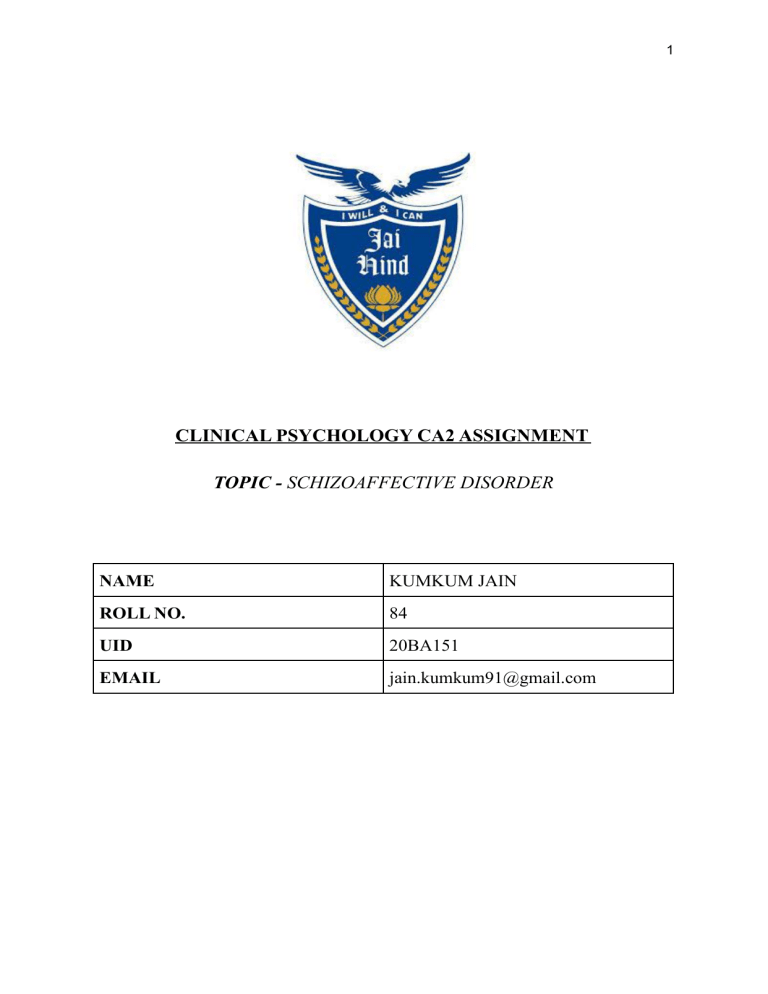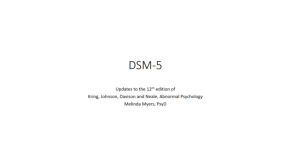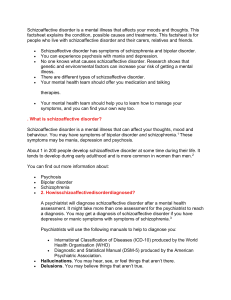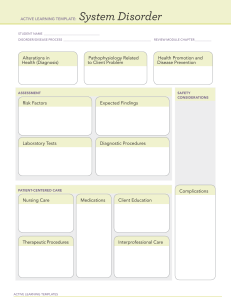
1 CLINICAL PSYCHOLOGY CA2 ASSIGNMENT TOPIC - SCHIZOAFFECTIVE DISORDER NAME KUMKUM JAIN ROLL NO. 84 UID 20BA151 EMAIL jain.kumkum91@gmail.com 2 SCHIZOAFFECTIVE DISORDER INTRODUCTION A chronic mental health illness known as schizoaffective disorder is primarily characterised by symptoms of schizophrenia, such as hallucinations or delusions, and signs of a mood disorder, such as mania and depression. Schizoaffective disorder affects .03% of the population, or very few people. Men are just as likely as women to develop it, but men typically do it early adulthood.. Schizoaffective disorder exhibits both psychotic and mood disorder symptoms, and, like mood disorders, there are various varieties of schizoaffective disorder. ● Manic type: During an episode of this kind, you experience both psychotic and manic symptoms. ● Depression type: During an episode, this kind causes you to experience both psychotic and depressive symptoms. ● Mixed kind: This type includes both manic and depressed symptoms along with psychotic symptoms. However, the psychotic symptoms are separate from the bipolar illness symptoms and are not always connected to them. CHARACTERISTIC SYMPTOMS ACCORDING TO DSM-V ● Schizoaffective disorder is described by the American Psychiatric Association in the DSM-5, the standard reference work on mental illness and personality disorders. The primary criteria (Criterion A) for schizophrenia, which includes two or more of the following, are met by a person with schizoaffective disorder. ● Delusions ● Hallucinations ● Disorganised speech (speech that is easily derailed or is incoherent) ● catatonic or utterly disordered behaviour ● Negative symptoms (flat facial expressions, anhedonia (loss of pleasure), avolition (lack of motivation), and other "taken away" feelings) At least two of the aforementioned symptoms of psychotic illnesses, along with these DSM-5 criteria, are present in schizoaffective disorder. ● An extreme mood change that lasts for a long time (either serious depression or mania). ● when experiencing delusions or hallucinations for two or more weeks in a row without experiencing depressive symptoms. ● Mood disturbances are present in the majority of instances. ● The symptoms are not a result of drug addiction. 3 TREATMENT PLAN The best treatment for schizoaffective disorder typically involves a triage of drugs, psychotherapy, and life skills instruction. Psychotherapy will typically take place in an individual setting because people with these disorders are typically too socially awkward to undergo group therapy. Because it provides the client with a warm, supportive, change-oriented atmosphere in which to explore their own progress while feeling stable and secure, supportive, client-centred, non-directive psychotherapy is a modality that is frequently used in clinical settings. The type and degree of symptoms, as well as whether the disease is depressed or bipolar, all affect how a person is treated. Hospitalisation may be required in specific situations. Symptom management may be aided by long-term treatment. Medication - Typically, doctors administer drugs for schizoaffective disorder to treat depression, ease psychotic symptoms, and stabilise mood. These medicines could consist of: ● Antipsychotics: The antipsychotic medicine paliperidone is the only pharmaceutical recommended by the Food and Drug Administration especially for the treatment of schizoaffective disorder (Invega). To help treat psychotic symptoms including hallucinations and delusions, doctors may however prescribe additional antipsychotic medications. ● Mood stabilisers: It can help balance out the highs and lows of manic episodes in bipolar schizoaffective disorder. ● Antidepressants: It can help with feelings of melancholy, hopelessness, or trouble sleeping or concentrating when depression is the underlying mood condition. Psychotherapy - The best course of action for the efficient treatment of schizoaffective disorder is a mix of medicines and psychotherapy. Psychoeducation, supportive treatment, cognitive-behavioural therapy, and family participation are some of the most widely used psychotherapy techniques. ● Cognitive-behavioural Therapy (CBT) - The basic goal of CBT is to assist a person with this condition in becoming more aware of distorted beliefs and actions that may be causing symptoms, as well as to help them create more adaptive and rational coping mechanisms. For treating psychotic symptoms like delusions and hallucinations, CBT can be beneficial. ● Family therapy: The family of a person with schizoaffective disorder may be impacted by the diagnosis. Family involvement in care is essential to getting closest friends and family on board with therapy. They can also help you manage treatment outside of the doctor's office by providing insightful information on symptoms. ● Art therapy: For those who have trouble expressing their difficulties and feelings with this condition, art therapy may be helpful. A mode of expressing experiences and emotions through art therapy other than through words. ● Psychoeducation: It has been demonstrated that increasing knowledge of illness while receiving supportive therapy can alter the illness's overall trajectory. 4 ● Support groups: Support groups offer a positive and secure setting to connect with others who share the same condition. Life skills training- Developing social and career skills can lessen loneliness and enhance quality of life. ● Social skills training: This focuses on enhancing social relationships, communication, and participation in everyday activities. It is possible to exercise brand-new abilities and conduct tailored to environments like the home or office. ● Vocational rehabilitation and supported employment: Helping those with schizoaffective disorder get ready for, get, and keep jobs is the main goal of this. Hospitalisation - Hospitalisation may be necessary to mitigate that risk, appropriate nutrition, sufficient sleep, and basic personal care during crisis situations or times of severe symptoms. Electroconvulsive therapy - Electroconvulsive therapy (ECT) may be an option for people with schizoaffective disorder who may not respond to counselling or medication. 5 REFERENCES Schizoaffective disorder - Diagnosis and treatment - Mayo Clinic. (2019a, November 9) https://www.mayoclinic.org/diseases-conditions/schizoaffective-disorder/diagnosis-treatment/ drc-20354509 Schizoaffective disorder. NAMI. (n.d.). from https://www.nami.org/About-Mental-Illness/Mental-Health-Conditions/Schizoaffectiv e-Disorder Peterson, T. J. (n.d.). Diagnosing schizoaffective disorder: DSM-5 criteria. Healthy Place. Retrieved December 9. 2022. from https://www.healthyplace.com/thought-disorders/schizoaffective-disorder-information /what-is-schizoaffective-disorder-dsm-5-criteria John M. Grohol, P. D. (2016, May 17). Schizoaffective disorder treatment. Psych Central. Retrieved December 9, 2022, from https://psychcentral.com/disorders/schizoaffective-disorder-treatment#1







